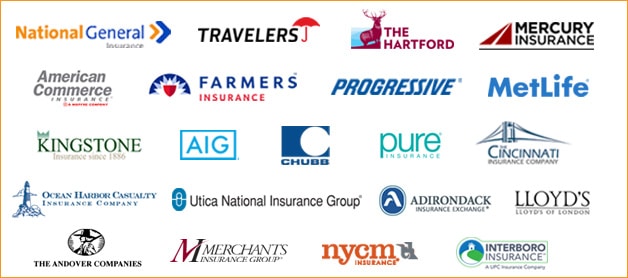Oyster Bay NY Home Insurance
One Simple Form Gets You The Best Quotes In Minutes!
Get 10 Quotes from Top-Rated Insurance Companies
Oyster Bay NY Homeowners Insurance Quotes
NY Homeowner’s Policy
Looking for the most affordable homeowners insurance quote in Oyster Bay NY? Our team of specialists are here to help you find the best rate. You will receive up to 10 Free Quotes along with our professional recommendation on which company will offer you the best value.
Our process is easy. You pick the coverage and endorsements that are important to you, and we find the company that delivers those coverages at the best price. Fill out the form by clicking the Get a Quote button or give us a call to speak with one of our Oyster Bay insurance experts.
Oyster Bay NY Homeowners Insurance Policy Options:
1. Coverage A – Primary structure – Commonly referred to as “dwelling”—This is simply your house.
2. Coverage B – Other Structures -Sheds, garages, and other unattached structures are covered with this premium. This is equal to 10% or less the value of coverage A.
3. Coverage C – Personal Property – This covers personal belongings like furniture or electronic items. This is up to 50% of coverage A, and some insurers allow you to cover for replacement cost. You can also choose other coverage for silverware, firearms, and other personal items in your home.
4. Coverage D – Loss of Use – This is valued at up to 20% of coverage A, where you will receive compensation for hotel, motel, dining, and other expenses, in the event you can’t stay in your home for a period of time due to damage.
5. Coverage E – Liability – If your dog bites a visitor in your home and a lawsuit is pending, this insurance covers you. Basically it protects you from personal liability for these and other possible issues which arise on your property.
6. Coverage F – Medical Payments – This covers medical expenses for coverage E injuries regardless of which party is at fault.
GET RATES FROM OUR TOP INSURANCE EXPERTS
Insured policy options:
“All risk” and “Named Perils” are the two options of coverage you can choose from when it comes to a homeowner’s insurance policy. With named perils, you are covering the specific perils that are named within the policy, for example: wind, fire, theft, etc. All-risk coverage will simply cover you for everything except for those perils that are specifically excluded, for example: flood, nuclear, war, etc.
With this coverage you have five types of policy options, which are:
A) HO1 – This is basic coverage protecting 11 named perils which include: lighting/electric, mischief, civil unrest, explosions, etc.
B) HO2 – This protects HO1, plus 7 additional named perils including: falling items, bursting steam/water, leaking, freezing pipes, etc.
C) HO3 – This protects HO1 and HO2, plus named contents in your home. This is typically the most chosen policy protection option for homeowners.
D) HO3 with HO15 – Covers your home and personal property plus unnamed items in the above coverage options. It is the broadest of all protection options.
E) HO8 – This is a modified policy which covers architectural homes, preserved homes, and is typically geared towards older homes in need of additional structural protection on them.
Other coverage options –
HO6 – This condo protection policy covers items not protected under your HOA. Floors, ceiling covers, and accessories. It protects additional coverage for medical protection, loss of land use, and other personal loss.
HO4 – Renter’s coverage protects the home for items not covered in HO2 and covers for additional living expenses if required depending on the level of damage to the home.
Optional Coverage Options
You can buy additional protection to cover personal endorsements in your homeowner’s policy. These endorsements include:
- Guaranteed dwelling which covers your home’s market value.
- Guaranteed contents covers items in the home, minus depreciation value over time.
- Other structural endorsements cover larger structures like a gazebo or detached structures.
- Sewer and drain covers from leaks, or burst pipes not covered above.
- Scheduled personal endorsements covers items like jewelry, collections, firearms, etc.
- Blanket endorsement covers scheduled personal endorsements like an umbrella coverage. No standard limits are in place for this coverage.
- Secondary residence applies to coverage for any secondary homes you own.
- Home daycare covers your home if it is used for this business purpose.
- Business pursuits covers your home if you operate a business out of it. Computers, electronics, and other items used in the line of business, are covered under this protection endorsement.
- Home business endorsement extends to businesses operated out of the home; this protection is only available for small businesses run out of the home.
- Personal injury covers you if you are sued for defamation, and similar lawsuits, it also extends to rental properties.
- Ordinance coverage protects your home under current codes which are in place.
- Watercraft endorsement covers vessels, boats, and small marine vessels you own.
- Theft coverage protects motor vehicles, vessels, trailers, or similar items, without forced entry.
- Credit card forgery protects for unauthorized use of stolen credit cards from the home.
- Flood insurance should be purchased if you live in a plain area. NFIP (national flood insurance protection) offers different coverage terms.
- Earthquake insurance is available with most insurers for damage stemming from earthquakes. Coverage levels and costs will vary typically based upon where you live and possibility of such occurrences in the area.
Discount options available:
Discounts up to 14% may be extended for new homes. Security systems like deadbolts, or monitoring systems may also provide discounts of 1 to 5% for homeowners. With sophisticated monitoring equipment, up to 20% discounts may also be extended to homeowners.
For those who combine their policies with the same insurer, discounts ranging from 5 to 15% are offered on certain premium coverage options purchased. Carrier longevity also provides a discount; depending on how long you’ve been with an insurer, your rates will go down over the years. Retired homeowners can also save on average up to 5% on their coverage premium with insurers. And, as a non-smoker, there are certain carriers which do provide a discount of up to 5% on the homeowner and additional coverage options you purchase through them.
Shop for competitive rates on any type of insurance!
Related News on Homeowners Insurance
11 Methods To Effectively Lower Your Homeowners Insurance Costs
Based on the insurance company you’re going to purchase your policy from, the price you pay for your homeowners insurance policy can range quite a bit. Therefore, if you plan on getting one soon, but you don’t want to pay top dollar for it, here are some of the best ways you can get great coverage without breaking the bank. Read more>>>
How To Choose a Deductible for Your Homeowners Insurance
One crucial factor that directly influences whether people can make the most of their NY home insurance policy or not is the type of deductible they choose. Since each homeowners policy comes with a deductible, consumers should have the knowledge necessary to make an informed insurance purchase. To help make the best decision we’ve come up with the following guide. Read more>>>
7 Factors that Affect Your NY Home Insurance Premium
Have you ever asked yourself why insurance firms charge varying premiums to different people? There are a number of factors that they consider before making a decision on the final cost of your New York home insurance premium. Read more>>>
Information about Oyster Bay NY – Nassau County
The Town of Oyster Bay is easternmost of the three towns in Nassau County, New York, in the United States. Part of the New York metropolitan area, it is the only town in Nassau County that extends from the North Shore to the South Shore of Long Island. As of the 2010 census, the town population was 293,214.
There are 18 villages and 18 hamlets within the town of Oyster Bay. The U.S. Postal Service has organized these 36 places into 30 different 5-digit ZIP codes served by 20 different post offices. Each post office has the same name as a hamlet or village, but the boundaries are seldom the same.
Oyster Bay is also the name of a hamlet on the north shore, within the town of Oyster Bay. Near this hamlet, in the village of Cove Neck, is Sagamore Hill, the former residence and summer White House of Theodore Roosevelt and now a museum. At least six of the 36 villages and hamlets of the town have shores on Oyster Bay Harbor, an inlet of Long Island Sound, and many of these at one time or another have also been referred to as being part of the hamlet of Oyster Bay.
History
The area was originally part of the colony of New Amsterdam. In 1639, the Dutch West India Company made its first purchase of land on Long Island from the local Indians. The Dutch did not dispute English claims to what is now Suffolk County, but when settlers from New England arrived in (present-day) Oyster Bay in 1640, they were soon arrested as part of a boundary dispute. In 1643, Englishmen purchased land in the present-day town of Hempstead from the Indians that included land purchased by the Dutch in 1639. Nevertheless, in 1644, the Dutch director granted a patent for Hempstead to the English. The Dutch also granted other English settlements in Flushing, Newtown, and Jamaica. In 1650, the Treaty of Hartford established a boundary between Dutch and English claims at “Oysterbay”, by which the Dutch meant present-day Cold Spring Harbor (to the east) and the English meant all the water connected to present-day Oyster Bay Harbor. Meanwhile, the government of England came under the control of Oliver Cromwell as a republic, and smugglers took advantage of the unresolved border dispute. In 1653, English settlers made their first purchase of land in Oyster Bay from the local Matinecock tribe, though there were already some rogue English settlements there. The monarchy was restored in England in 1660, and in 1644 King Charles gave Long Island (and much else) to his brother James, leading to the Dutch relinquishing control of all of New Amsterdam. In 1667 the settlement at Oyster Bay received its charter from the new English colony of New York, becoming the Township of Oyster Bay. By 1687, the last piece of land was sold by the Indians, and few remained by 1709.
During most of the American Revolution the town was under the control of English forces. The town was originally part of Queens County, until the western portion of that county was amalgamated into New York City in 1898 and Nassau County was created in 1899. In 1918 Glen Cove incorporated as a city and formed a governing system separate from the town. Following World War II, housing replaced farmland as the population grew from about 40,000 in 1950 to more than 290,000 in 1990.
Oyster Bay is home to the Seawanhaka Corinthian Yacht Club, one of the oldest yacht clubs in the Western Hemisphere, which opened in 1871. There are 40 buildings and sites presently named Town of Oyster Bay Landmarks.










